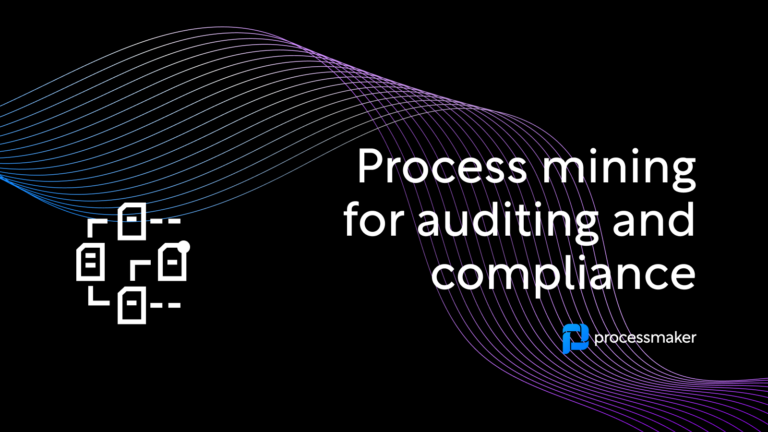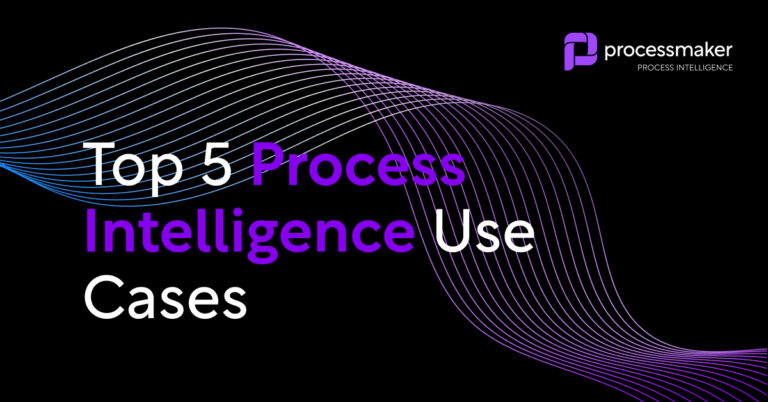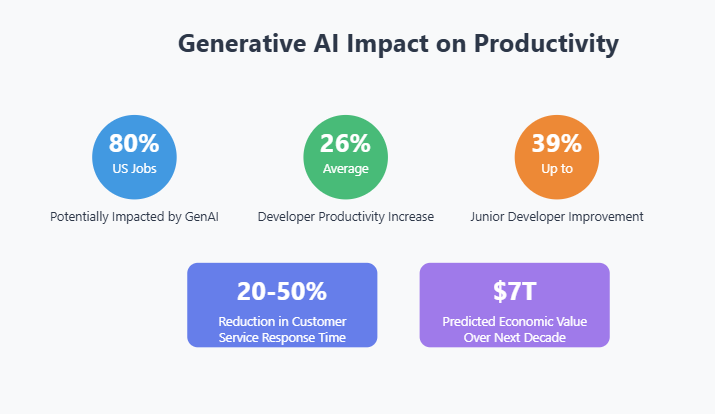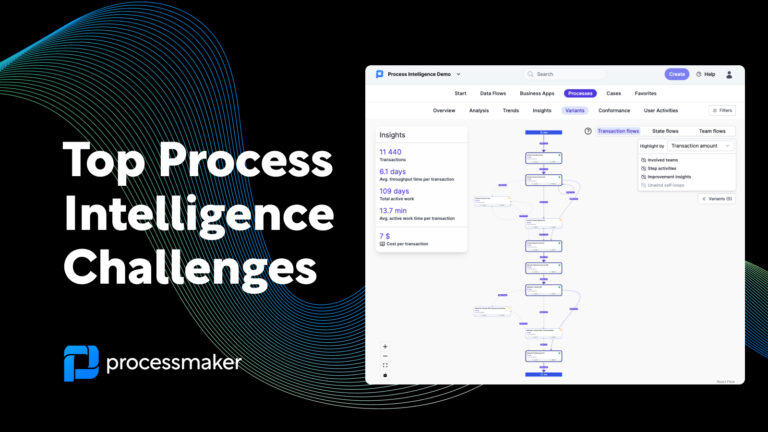Process mining software has significantly transformed auditing, offering new capabilities for insights, accuracy, and compliance. This article provides a comprehensive exploration of these two fields and gives you the essentials every enterprise leader needs to know.
What exactly is process mining?
At its core, process mining is a way to uncover the health of business processes based on data found with the different IT systems an organization uses. Process data is crucial in this context as it helps organizations identify and analyze processes efficiently. You can think of it as the use of data mining techniques in the field of business process management.
Process mining brings advanced analytical capabilities to business executives in knowledge-intensive areas such as audit. By leveraging event logs from various IT systems, it provides real-time insights into process flows, helping to uncover potential process variations, potential compliance issues, and opportunities for improvement.
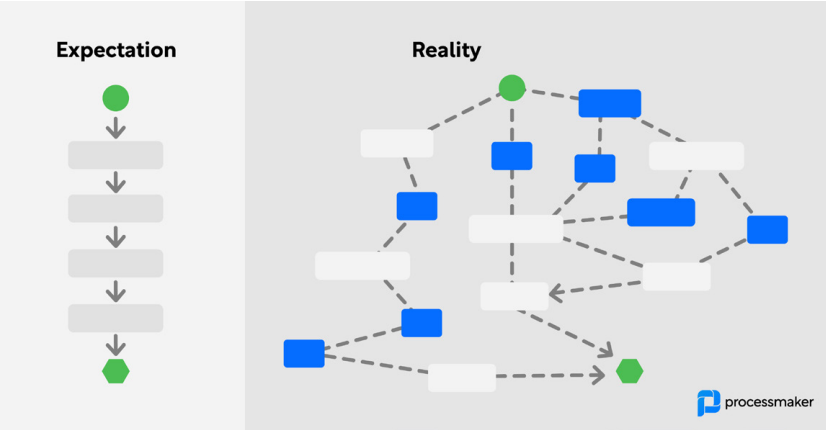
Why use process mining in auditing?
Auditing is a domain that requires meticulous examination of business operations, financial statements, and records. Traditional auditing methods, while effective, can be laborious and time-consuming.
Process mining algorithms comes into play here, offering a solution that’s not just efficient but also highly reliable. This technology facilitates process improvement by providing insights into how processes operate and identifying areas for enhancement. In contrast to manual approaches, process mining can offer greater speed and accuracy to analyse enterprise data and processes.
An X-ray into the health of enterprise with process mining software
Process mining is not a new technology but is increasingly applied to the field of data-driven auditing. EY estimates that audit and control-related activities account for 19% of the common opportunities to use process mining.1
The synergy between process mining and auditing is quite profound. You can think of both as a type of x-ray scan into the health of an organization. Both aim to assess, analyze, and improve the operational landscape of a business.
By integrating process mining techniques into auditing, auditors can perform more effective evaluations with a greater level of detail and accuracy.
Where process mining can support your internal audit team
With process mining, auditing shifts from a predominantly manual process to a largely automated one. This technology provides objective insights derived from actual data, optimizing existing business processes. Auditors and internal audit specialists can evaluate an entire process from start to finish, helping them to identify anomalies, detect fraud, and ensure compliance with organizational policies and regulatory standards.
Discover the root causes faster
Process mining can be an invaluable tool for auditors seeking to uncover the root causes of issues within an organization’s operations.
By mapping out the entire process based on event logs from IT systems, process mining provides a clear visualization of workflows, transactions, and operational sequences. This enables auditors to spot discrepancies, bottlenecks, and irregularities that could indicate deeper issues.
Moreover, process mining’s real-time data analysis can highlight anomalies as they occur, providing immediate insights into their origin. Therefore, by analyzing patterns and deviations within these comprehensive process maps, auditors can efficiently trace back any operational problems to their root causes, enhancing the accuracy and efficacy of their audit procedures.
Increase accuracy and transparency in financial reporting
Process mining significantly enhances the accuracy and transparency of financial reporting by providing a detailed, data-driven view of business processes. It employs algorithms to analyze event logs from various systems involved in financial transactions, enabling a comprehensive review of every action taken.
This means each transaction, workflow, or financial operation can be traced back to its origin, reducing the risk of errors, fraud, or discrepancies. It also ensures every process involved in financial reporting is transparent and verifiable.
Furthermore, the real-time nature of process mining aids in promptly identifying and rectifying any issues, thereby minimizing their impact on financial statements. Overall, process mining contributes to more accurate, reliable, and transparent financial reporting, leading to greater trust and confidence among stakeholders.
Test financial control
Process mining aids auditors in testing financial control in an enterprise by providing a complete, data-driven view of the financial workflows. It uses real business transaction and activity data from enterprise systems to map out the entire financial process, from transaction initiation to final reporting. This allows auditors to scrutinize every step and identify any deviations from the expected controls, which could indicate control weaknesses or non-compliance issues.
In addition, process mining supports continuous auditing by delivering real-time insights, enabling auditors to conduct ongoing control assessments rather than periodic checks. This comprehensive, real-time view of the financial controls helps auditors ensure the enterprise is adhering to internal policies and external regulations, thereby strengthening the integrity of financial operations.
Benefits of process mining in auditing
Process mining brings many benefits to the auditing realm, including:
- Cheaper, faster auditing. By taking the manual data crunching out of compliance, process mining can make audits both more cost-effective and radically faster. Process mining platforms are essential software solutions that assist organizations in analyzing and visualizing their business processes through data sourced from various inputs like transaction logs.
- Increased efficiency and accuracy. By examining the entire process, auditors can reduce the risk of errors and inaccuracies. Auditors can quickly map out and visualize processes, saving time and resources.
- Better compliance. Process mining helps auditors reduce organizational risk and ensure compliance by identifying deviations from standard procedures, for example, in the form of maverick buying or shadow IT.
- Data-driven decision making. Enterprise leaders can take control measures into their own hands by continuously monitoring, reacting faster to potential risks, and ensuring process compliance.
Challenges and solutions in implementing process mining for auditing
While the benefits are clear, implementing Process Mining for auditing does present certain challenges. Process mining work involves extracting data from event logs in information systems to visualize and understand business processes. These include:
- Data quality: Poor data quality can affect the accuracy of process mining results. This can be addressed by implementing robust data-cleaning methods.
- Complexity: The complexity of processes can make it difficult to understand the results of process mining. Training and education can help auditors interpret these results effectively.
- Privacy concerns: Process mining can potentially expose sensitive information. Appropriate data protection measures should be employed to ensure privacy and confidentiality.
- Slow implementation: if you’re looking to use process mining in an organization with many source systems and business applications process mining technology can be slow to implement.
Business process management and process mining
Business process management (BPM) is a comprehensive approach to overseeing and improving business processes. It involves designing, modeling, executing, monitoring, and optimizing processes to achieve organizational goals. Process mining plays a crucial role within BPM by providing a data-driven perspective on how processes actually function.
By integrating process mining into BPM, businesses can identify bottlenecks, inefficiencies, and deviations from standard procedures. This data-driven insight allows for more precise and effective process improvements. BPM provides the framework for implementing these changes and monitoring their impact, ensuring that business processes are continuously optimized for better performance.
How process mining can help external auditors
Process mining can also substantially help auditing companies and external auditors improve their own processes and auditing operations. It serves as a bridge between data science and process science, providing a theoretical foundation for understanding and optimizing business processes.
Identifying inefficiencies
Process mining technology gives many of the same benefits to auditing companies as potential clients, starting with the full end-to-end transparency into business operations, processes and IT system use.
Process mining visualizes the key auditing workflows, exposing bottlenecks, unnecessary steps, or deviations from the standard procedures. By pinpointing these inefficiencies, auditing companies can streamline their operations, improve workflow efficiency, and save time and resources.
Streamline and improve operations through process improvement
Auditing processes require significant expertise, time and resources to execute at the high standards of customers. Process mining tools can help auditors identify streamlining opportunities that can both reduce audit time and reduce costs.
By uncovering new insights about their operations, auditing companies can also use process mining to drive innovation. They can identify areas for technological advancement or process re-engineering, leading to improved services and competitive advantage.
Enhancing accuracy
Through process mining, auditing companies can trace each operation to its origin, reducing the risk of errors and inaccuracies in auditing processes. This ensures a high level of accuracy in audit findings and improves the reliability of the auditing services they offer.
With real-time data analysis, process mining facilitates continuous auditing. Auditors can respond immediately to potential issues, making the audit process more proactive rather than reactive.
Improving compliance
Process mining helps auditors ensure better statutory compliance with industry standards and regulations by identifying deviations from prescribed procedures. This can lead to improved internal controls and adherence to compliance requirements.
In highly regulated industries such as auditing, process mining technology can improve compliance by giving early indications when processes are not followed, or areas where additional conformance checks are needed.
Best practices for process mining in auditing
When leveraging process mining in auditing, adhering to best practices is essential for achieving optimal results. Here are some key guidelines:
- Ensure data accuracy and completeness: The foundation of effective process mining is reliable data. This involves thorough data cleansing and validation to ensure the event logs used are accurate and complete.
- Define clear goals and objectives: Establish specific aims for the process mining project, such as identifying inefficiencies, detecting fraud, or ensuring compliance. Clear objectives guide the analysis and help focus efforts on achieving tangible outcomes.
- Utilize the right tools and techniques: Select appropriate process mining tools and techniques tailored to the auditing needs. This may include machine learning algorithms for advanced analysis or process discovery techniques to map out workflows.
- Ensure actionable results: The insights gained from process mining should be practical and actionable. Auditors should be able to use these results to drive meaningful business improvements, whether it’s streamlining processes or enhancing compliance measures.
Next steps to digital compliance management
The future of process mining in auditing appears promising. As businesses continue to digitize their operations, the demand for innovative auditing solutions will increase. Process mining, with its ability to provide comprehensive and accurate insights into operational processes, is set to become a vital tool in the auditor’s toolkit.
The fusion of process mining and auditing represents a transformative shift in how businesses evaluate and improve their operational processes. It offers enhanced efficiency, accuracy, and insights, thereby paving the way for a more informed, proactive approach to both internal and external auditing.
Conclusion
In conclusion, process mining is a transformative tool for businesses aiming to enhance their processes and operations. By analyzing data from business processes, it uncovers trends, patterns, and areas for improvement, enabling data-driven decision-making. In the realm of auditing, process mining helps identify inefficiencies, detect fraud, and ensure compliance. As the field evolves, staying abreast of the latest tools, techniques, and best practices will be crucial for businesses to fully leverage the power of process mining technology.
